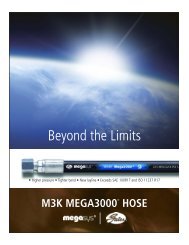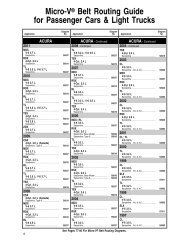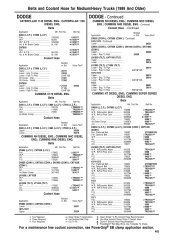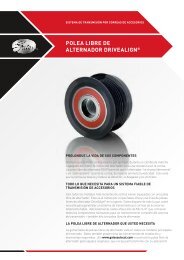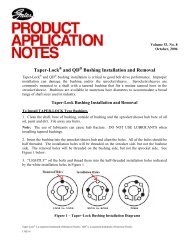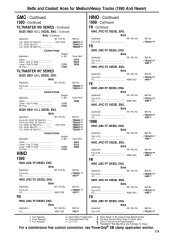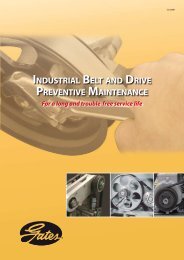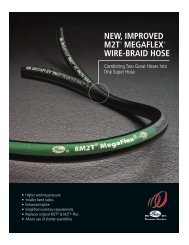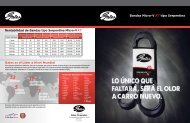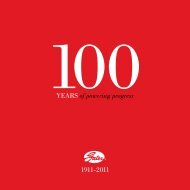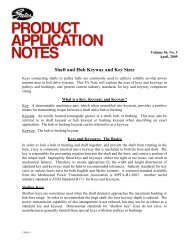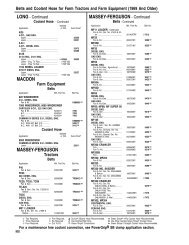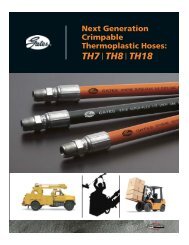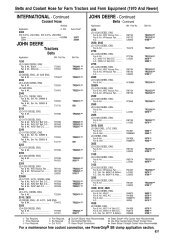PowerGrip® GT® Belt Drives
PowerGrip® GT® Belt Drives
PowerGrip® GT® Belt Drives
Create successful ePaper yourself
Turn your PDF publications into a flip-book with our unique Google optimized e-Paper software.
Synchronous <strong>Belt</strong> <strong>Drives</strong> – Engineering<br />
IV. Installation and<br />
Take Up<br />
A. Installation Allowance<br />
When designing a drive system for a production<br />
product, allowance for belt installation must be built<br />
into the system. While specific installation<br />
allowances could be published, as they are for<br />
larger industrial belt drives, small synchronous<br />
drive applications are generally quite diverse<br />
making it nearly impossible to arrive at values that<br />
apply in all cases. When space is at a premium, the<br />
necessary installation allowances should be<br />
determined experimentally using actual production<br />
parts for the best possible results.<br />
B. <strong>Belt</strong> Installation<br />
During the belt installation process, it is very<br />
important that the belt be fully seated in the sprocket<br />
grooves before applying final tension. Serpentine<br />
drives with multiple sprockets and drives with large<br />
sprockets are particularly vulnerable to belt<br />
tensioning problems resulting from the belt teeth<br />
being only partially engaged in the sprockets during<br />
installation. In order to prevent these problems, the<br />
belt installation tension should be evenly distributed<br />
to all belt spans by rotating the system by hand.<br />
After confirming that belt teeth are properly engaged<br />
in the sprocket grooves, belt tension should be rechecked<br />
and verified. Failure to do this may result<br />
in an under-tensioned condition with the potential<br />
for belt ratcheting.<br />
C. <strong>Belt</strong> Take-Up<br />
Synchronous belt drives generally require little if<br />
any tensioning when used in accordance with<br />
proper design procedures. A small amount of belt<br />
tension decay can be expected within the first<br />
several hours of operation. After this time, the belt<br />
tension should remain relatively stable.<br />
D. Fixed Center <strong>Drives</strong><br />
Designers sometimes attempt to design<br />
synchronous belt drive systems without any means<br />
of belt adjustment or take up. This type of system is<br />
called a Fixed Center Drive. While this approach is<br />
often viewed as being economical, and is simple for<br />
assemblers, it often results in troublesome reliability<br />
and performance problems in the long run.<br />
The primary pitfall in a fixed center design approach<br />
is failure to consider the effects of system tolerance<br />
accumulation. <strong>Belt</strong>s and sprockets are<br />
manufactured with industry accepted production<br />
tolerances. Ther are limits to the accuracy that the<br />
center distance can be maintained on a production<br />
basis as well. The potential effects of this tolerance<br />
accumulation is as follows:<br />
Low Tension:<br />
Long <strong>Belt</strong> with Small Sprockets on a Short Center<br />
Distance<br />
High Tension:<br />
Short <strong>Belt</strong> with Large Sprockets on a Long Center<br />
Distance.<br />
<strong>Belt</strong> tension in these two cases can vary by a factor<br />
of 3 or more with a standard fiberglass tensile cord.<br />
This potential variation is great enough to overload<br />
bearings and shafting, as well as the belts<br />
themselves. The probability of these extremes<br />
occurring is a matter of statistics, but however<br />
remote the chances may seem, they will occur in a<br />
production setting. In power transmission drives,<br />
the appearance of either extreme is very likely to<br />
impact drive system performance in a negative<br />
manner.<br />
The most detrimental aspect of fixed center drives is<br />
generally the potentially high tension condition.<br />
This condition can be avoided by adjusting the<br />
design center distance. A common approach in<br />
these designs is to reduce the center distance from<br />
the exact calculated value by some small fraction.<br />
This results in a drive system that is inherently<br />
loose, but one that has much less probability of<br />
yielding excessively high shaft loads. NOTE: This<br />
approach should not be used for power<br />
transmission drives since the potentially loose<br />
operating conditions could result in accelerated<br />
wear and belt ratcheting, even under nominal<br />
loading.<br />
There are times when fixed center drive designs can’t be<br />
voided. In these cases, the following recommendations<br />
will maximize the probability of success.<br />
1. Do not use a fixed center design for power<br />
transmission drives. Consider using a fixed<br />
center design only for lightly loaded or<br />
motion transfer applications.<br />
2. Do not use a fixed center design for drives<br />
requiring high motion quality or registration<br />
precision.<br />
3. When considering a fixed center design, the<br />
center distance must be held as accurately as<br />
possible, typically within 0.002" – 0.003"<br />
(0.05mm – 0.08mm). This accuracy often<br />
requires the use of stamped steel framework.<br />
Molding processes do not generally have the<br />
capability to maintain the necessary<br />
accuracy.<br />
4. Sprockets for fixed center systems should be<br />
produced with a machining process for<br />
accuracy. Molding and sintering processes are<br />
generally not capable of holding the finished<br />
O.D. sufficiently accurate for these systems.<br />
5. The performance capabilities of the drive<br />
system should be verified by testing belts<br />
produced over their full length tolerance<br />
range on drive systems representing the full<br />
potential center-distance variation. Contact<br />
Gates Application Engineering for further<br />
details.<br />
6. Contact Gates Application Engineering for<br />
design center distance recommendations,<br />
and to review the application.<br />
V. Idler Usage<br />
Idlers in synchronous belt drives are commonly<br />
used to take up belt slack, apply installation tension<br />
or to clear obstructions within a system. While<br />
idlers cause additional belt bending, resulting in<br />
fatigue, this effect is generally not significant as<br />
long as proper design procedures are followed.<br />
Synchronous belts elongate very little over time<br />
making them relatively maintenance free. All idlers<br />
should be capable of being locked down after being<br />
adjusted and should require little additional<br />
attention. Specific guidelines and recommendations<br />
follow in the upcoming paragraphs.<br />
A. Inside/Outside<br />
Inside idlers are generally preferred over backside<br />
idlers from a belt fatigue standpoint. Both are<br />
commonly used with good success. Inside idlers<br />
should be sprockets, but can be flat if the O.D. is<br />
equivalent to the pitch diameter of a 40 groove<br />
sprocket. Backside idlers should be flat and<br />
uncrowned.<br />
B. Tight Side/Slack Side<br />
Idlers should be placed on the slack (or non-load<br />
carrying) side if possible. Their affect on belt<br />
fatigue is less on the slack side than on the tight (or<br />
load carrying) side. If spring loaded idlers are<br />
used, they should never be placed on the tight side<br />
(see D. Spring Loaded Idlers). Also note that drive<br />
direction reversal cause the tight and slack spans to<br />
reverse, potentially placing the idler on the tight<br />
side.<br />
The World’s Most Trusted Name in <strong>Belt</strong>s, Hose & Hydraulics.



